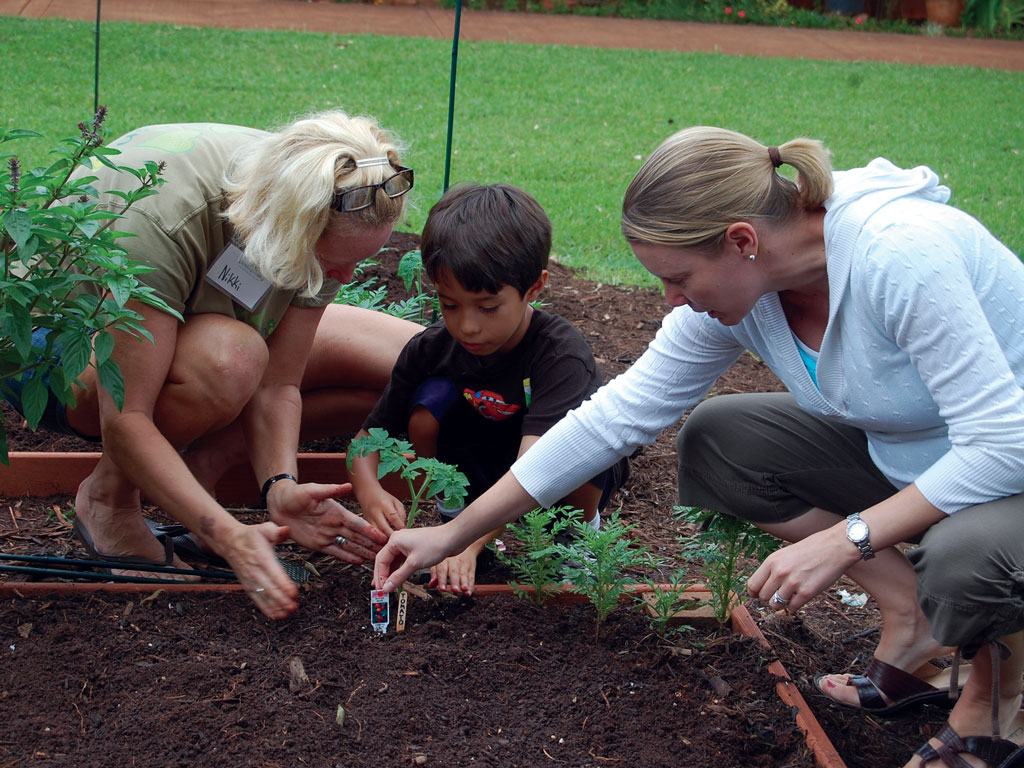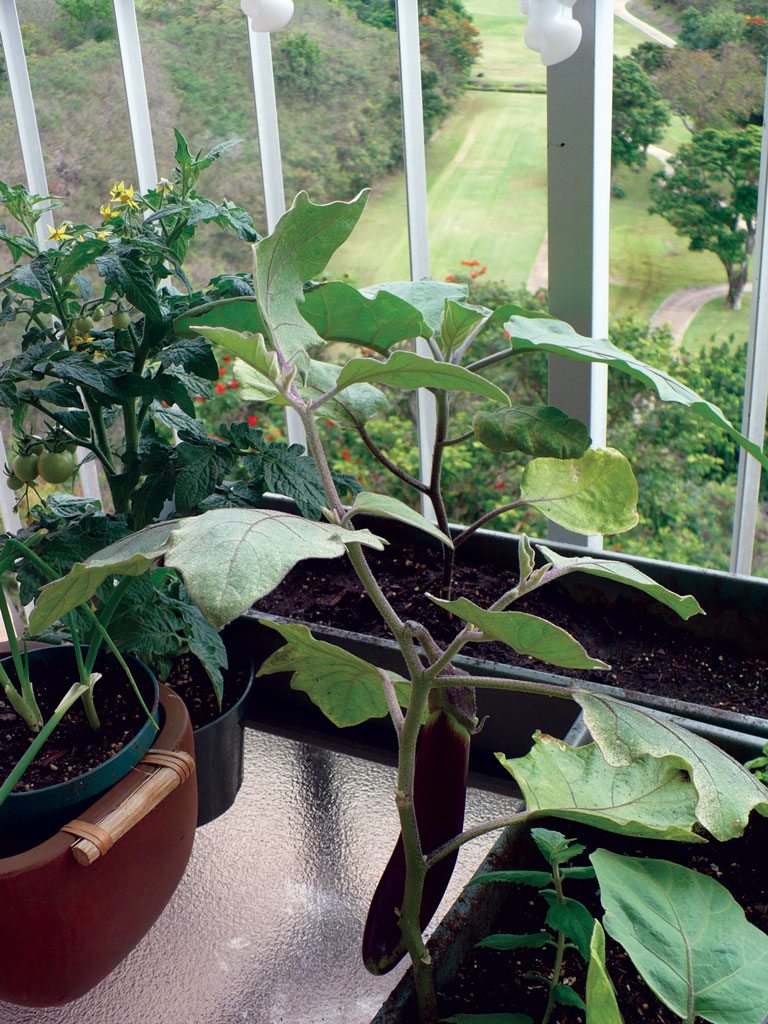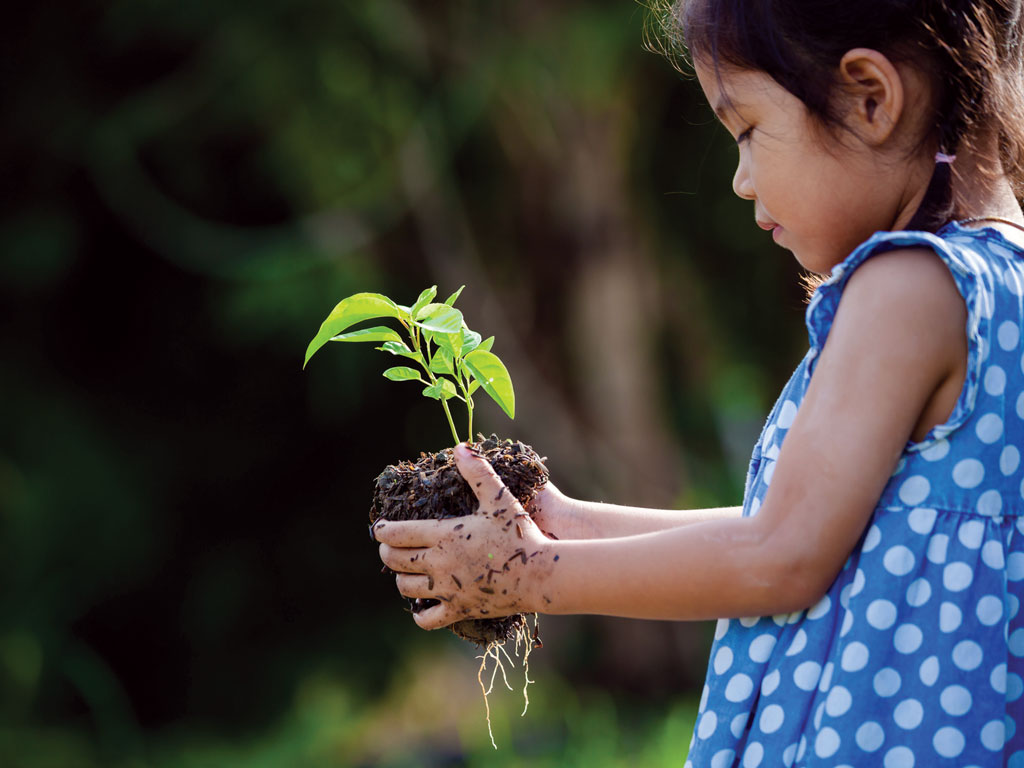by Kimberly Blaker
There’s no question, playing in the dirt tops the list of fun for kids, particularly young children, despite the protests of many well-intended parents. If you happen to be one of those worried parents, you can put your fears aside.
As it turns out, dirt is actually beneficial to the long-term health of kids, according to a Northwestern University article by Clare Milliken, “Germs at four, less inflammation at forty.” Studies have found that early exposure to certain germs, like those found in dirt, helps kids’ immune systems learn to regulate inflammation better. In turn, this exposure reduces risk for many diseases throughout life.
For that reason, a family garden is a perfect opportunity to build your kids’ immune systems. Better still, gardening offers further benefits to kids and families. Through gardening, kids learn to be responsible by caring for their own plants. It’s also a great way to help kids learn about and develop an appreciation for science. Also, gardening encourages healthier eating and is an excellent activity for family bonding.
So, gather up your kids and gardening supplies, head outdoors, and get ready for some dirt-filled fun. Whether you have a big backyard or live in an apartment, you can tailor your garden to suit your needs.

What Can They Learn?
Gardening with children is not only about planting seeds, weeding, and watching the fruits of your labor and love. It is also about conserving the earth and our home and recognizing our place in it. This is an opportunity to teach children how to compost, be a friend to wildlife and recycle.
Big garden, or small garden or no garden at all, it does not matter. You can encourage wildlife to come into the area. Children can learn about the beneficial insects as well as the not so beneficial. They can also learn about the important roles played by the bees and the birds.
Gardening with children is the perfect time to introduce them to the concept of recycling. Plastic bottles can be reused as plant covers to protect against the cold. Newspaper can be used to make seed pots and old bits of furniture can be used as containers or to build beds. The learning opportunities are endless.
Getting Started
First, decide where to plant your garden. Allow a small space for your child to have his or her own garden, too. This will help build their enthusiasm for the garden and encourage him or her to take ownership and responsibility for it. Having their own garden can be exciting and rewarding for kids because they know that they, alone (or with minimal help), grew those little seeds into a marvelous plant.
Next, decide what to plant. For young children, consider fast-growing plants they are familiar with. Little kids also love plants that are colorful or have strong scents. If your kids are older, let them choose what they want to grow. But keep in mind your child’s personality. If he tends to be impatient, suggest plants that are easy to care for and grow quickly.
As you proceed in planning and preparation, include your child in it as much as possible. Remember, this stage is as much fun for kids as it is for parents and helps build kids’ enthusiasm. When you go shopping for the supplies, take your kids along and let them pick out their own seeds and gardening tools. For the safety of young children, look for kids’ gardening tools made of durable plastic.

Planting Your Garden
When you begin planting, show your child how to plant the seeds and how to space them apart correctly. Then have your child water the seeds as directed. To help your child take responsibility for his or her own garden, put a daily gardening task list on the refrigerator.
Also, to help your child maintain enthusiasm, suggest keeping a garden log. Kids can have fun recording the date of plantings, each day’s gardening activities, when each plant sprouts, the amount of growth of the plants, and the harvesting.
Finally, after harvesting, have your child help you prepare the vegetables. Try different ways of preparing or cooking them to help your kid develop a life-long love for fresh, healthy veggies.
No Backyard? No Problem!
Families do not need to have a backyard to grow a garden. Families who live in an apartment building can still have a garden, and many herbs, vegetables and flowers can be grown easily on windowsills or even a window box.
In a small or terraced garden, families may be able to use a planter box or a row of pots to grow various plants. There are some ingenious and inventive planters and gardening containers available, or be creative and use wood, old milk bottles, broken teapots, galoshes, and any number of other common household objects. Vertical gardening, or growing plants up a trellis or wall, offers a great growing space for gardening with kids in small spaces.
Another growing trend is the community garden. Community gardens are places for the whole community to look after a plot of land, from a fruit orchard to allotments or simple gardens. These are a fantastic idea, as knowledge is passed down from generation to generation. There is a sense of community and working together to achieve a common goal. In 1975, the City and County of Honolulu started a Community Recreational Gardening Program, and it is still going strong. There are 10 community garden sites in the program around Oahu. To apply for a community garden plot, visit www.honolulu.gov/parks/hbg/community-gardens.


Growing Plants in Hawaii
Matching vegetables to the climate is a key element for any gardener. Most plants grow year-round in Hawaii, but some require planting and harvesting at certain times during the year. Tropical climates make growing cool-season vegetables in Hawaii difficult. Focus on growing plants which will flourish in year-round warmth offered by Hawaiian weather. Also, start with low maintenance plants to gauge your child’s contribution to the garden before advancing to plants that require lots of upkeep. The following flowers, fruits, and vegetables are great beginner garden plants for growing in Hawaii:
Fruits & Veggies: Cucumber, Tomato, ‘Uala (sweet potato), Leafy Greens (kalo, arugula, lettuce, kale), Taro, Corn, Papaya, Pineapple, Citrus Fruits, Ginger, Eggplant, Snap Peas, Long Beans, Basil, Peppers
Flowers & Other Plants: Lavender, Tropic Milkweed (attracts butterflies!), Dahlia, Plumeria, Hibiscus, Aloe Vera, Kupukupu (fern), Silversword, Birds of Paradise, Bee Balm, Daffodils, Lilies, Pohuehue (beach morning glory), Lantana
Resources for Learning More About Gardening in Hawaii:
- Guide for Hawaii Gardening Basics
- For Parents:
- For Teachers and Schools
- Waimea Valley Nursery Plant Sale: Every Saturday from 8AM-12PM
- Farmers Markets:
- Haleiwa, Thursday 2PM-6PM
- Kailua, Thursday 5PM-7:30PM
- Pearlridge, Saturday 8AM-12PM
- Kakaako, Saturday 8AM-12PM
- Waialua Sugar Mill, Saturday 8:30AM-12PM
- Bishop Museum’s Backyard Adventures Exhibit: Explore the world from the perspective of a bee and take a walk through a digital garden to see plants growing in super time at this engaging, interactive, and educational exhibit.
- Gardening centers at your local hardware stores: City Mill, Home Depot, Lowes, Walmart, etc.







